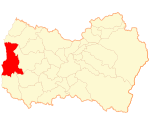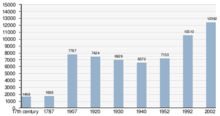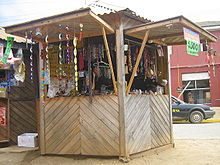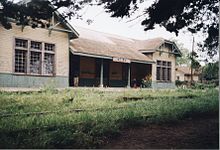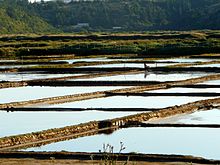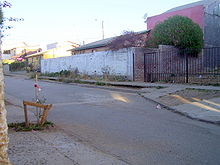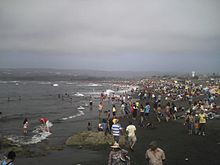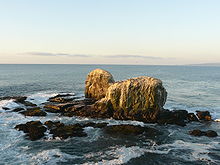- Pichilemu
-
"Pichilemo" redirects here. For other uses, see Pichilemo (disambiguation).
Pichilemu
Pichilemo— City — The Pichilemu city hall, as seen in April 2011 
Flag
Coat of arms
LogoNickname(s): Surf Capital (Capital del Surf) Location of the Pichilemu commune in O'Higgins Region Coordinates: 34°23′31″S 72°0′50″W / 34.39194°S 72.01389°W Country  Chile
ChileRegion  O'Higgins
O'HigginsProvince  Cardenal Caro
Cardenal CaroSettled January 24, 1544[1] Incorporated (city) December 22, 1891 Government – Mayor Roberto Córdova Carreño (2009–2012)[2] – City Council CouncilorsArea – Total 749.1 km2 (289.2 sq mi) Population (2010) – Total 14,302 – Density 19.09/km2 (49.4/sq mi) Demonym Pichileminian – pichilemino (Spanish) Time zone Chile Time (CLT)[3] (UTC-4) – Summer (DST) Chile Summer Time (CLST)[4] (UTC-3) ZIP codes 3220478 Website http://www.pichilemu.cl/ Pichilemu (Mapudungun: Small forest, pronounced: [pitʃiˈlemu] (
 listen)), originally known as Pichilemo,[5] is a beach resort city and commune in central Chile, and capital of Cardenal Caro Province. It is located southwest of Santiago, the capital of Chile, and comprises an urban center and twenty-three villages, such as Ciruelos, Cáhuil, and Espinillo. Pichilemu had approximately 14,302 residents as of 2010.
listen)), originally known as Pichilemo,[5] is a beach resort city and commune in central Chile, and capital of Cardenal Caro Province. It is located southwest of Santiago, the capital of Chile, and comprises an urban center and twenty-three villages, such as Ciruelos, Cáhuil, and Espinillo. Pichilemu had approximately 14,302 residents as of 2010.Pichilemu was founded by the inheritors of Lauriano Gaete and Ninfa Vargas in late 1891, and was established as an "autonomous commune" on December 22, 1891, by decree of President Jorge Montt and Interior Minister Manuel José Irarrázabal. The Pichilemu area was first populated by the indigenous Promaucaes. It was conceived as a beach resort for upper-class Chileans by Agustín Ross Edwards, a Chilean politician and member of the Ross Edwards family. Pichilemu is home to five historic monuments of Chile (Agustín Ross Cultural Centre, Agustín Ross Park, Pichilemu railway station, El Árbol tunnel, and Caballo de Agua), and part of the city was declared a Zona Típica ("Traditional Area" or "Heritage Site") by the National Monuments Council, in 2004.
The city is part of District No. 35 and is in the ninth senatorial constituency of O'Higgins Region electoral division. Pichilemu is home to the main beach in O'Higgins Region, and is a tourist destination for surfing, windsurfing and funboarding.
Tourism is the main industry of the city, but forestry and handicrafts are also important. Pichilemu has many expansive dark sand beaches. Several surf championships take place in the city each year at Punta de Lobos, which according to Fodor's is "widely considered the best surfing in South America year-round."
Contents
History
Main article: History of PichilemuPichilemu was inhabited by Promaucaes, a pre-Columbian tribal group, until the Spanish conquest of Chile.[6] They were hunter-gatherers and fishermen who lived primarily along the Cachapoal and Maule rivers.[6] The remaining Promaucaes were assimilated into Chilean society through a process of hispanicization and mestization after the conquest of Chile.[7]
Aureliano Oyarzún, professor of pathology at University of Chile, investigated pre-Ceramic middens from Pichilemu and Cahuil. His book Crónicas de Pichilemu–Cáhuil (Chronicles of Pichilemu–Cáhuil) was published posthumously, in 1957.[8] Tomás Guevara published two volumes of Historia de Chile, Chile Prehispánico (History of Chile, Pre-Hispanic Chile) in 1929, which discusses the indigenous center of Apalta, the Pichilemu middens, the Malloa petroglyphs, a stone cup from Nancagua, and pottery finds in Peralillo.[9]
José Toribio Medina (1852–1930), who was a writer and historiographer, spent most of his life in Colchagua Province, and completed his first archeological investigations in Pichilemu. In 1908, he published Los Restos Indígenas de Pichilemu (English: The Indigenous Remains of Pichilemu),[1][9] in which he stated that the Indians that were inhabiting Pichilemu when the Spaniards arrived at Chile were Promaucaes, part of the Topocalma encomienda, given on January 24, 1544, by Pedro de Valdivia to Juan Gómez de Almagro, therefore establishing Pichilemu.[1]
During the colonial and Republican periods, agriculture was promoted by the government. Many Chilean haciendas (estates) were successful during this time, including the Pichileminian Hacienda San Antonio de Petrel.[9] Part of the land where San Antonio de Petrel was created was given by the Captaincy General of Chile to Bartolomé de Rojas y Puebla in 1611, who later acquired more lands in order to establish it.[10] San Antonio de Petrel produced leather, jerky, soles, tallow, and cordovan, as well as other products which would later be exported to Peru, or sold in Santiago and Valparaíso.[10] San Antonio de Petrel was bordered by properties of Lauriano Gaete and Ninfa Vargas, and Pedro Pavez Polanco.
The area around Pichilemu was very densely populated, especially in Cáhuil, where there are salt deposits that were exploited by natives. Pichilemu has had censuses taken since the 17th century.[11]
In 1872, President of Chile Aníbal Pinto commissioned the corvette captain Francisco Vidal Gormaz to perform a survey of the coast between Tumán Creek and Boca del Mataquito. He concluded that Pichilemu was the best place to construct a ferry. The family of Daniel Ortúzar, inheritors of the hacienda San Antonio de Petrel, constructed a dock in 1875, which served as a fishing port for a few years, and would be decreed as a "minor dock" by President José Manuel Balmaceda in 1887.[11][12][13] Homes were built along the dock on what currently is the Daniel Ortúzar Avenue (Avenida Daniel Ortúzar).[14][15] The name Pichilemu comes from the Mapudungún words pichi (little) and lemu (forest).[16]
During the Chilean Civil War of 1891, Daniel Ortúzar and the priest of Alcones were transferred as prisoners from Pichilemu to Valparaíso via the dock,[17][18] which was later burned.[13] The dock was later reconstructed and used until 1912, but it never reached "port" status.[11][13]
The inheritors of Lauriano Gaete and Ninfa Vargas, who were proprietaries of the land which is currently Central Pichilemu, founded the town in late 1891 after conceiving the design of the city with engineer Emilio Nichón.[18] By decree of President Jorge Montt and his Interior Minister, Manuel José Irarrázabal, the city was officially established as an "autonomous commune" on December 22, 1891.[18][19] José María Caro Martínez became the first mayor of the city in 1894,[19] and regularized and improved the design of the city the same year.[15][18] Caro Martínez held the mayor office until 1905.[19]
 Agustín Ross, circa 1915
Agustín Ross, circa 1915
Agustín Ross Edwards, a Chilean writer, Member of Parliament, minister, and politician,[20][21][22] bought a 300-hectare (740-acre) tract of land, and named it La Posada, in 1885. At the time, it was merely a set of thick-walled barracks.[23]
Agustín Ross turned Pichilemu into a summer resort town for affluent people from Santiago. He designed an urban setting that included a park and a forest of over 10 hectares (25 acres).[23][24] He transformed La Posada into a hotel, named Gran Hotel Pichilemu, which has since been renamed to Hotel Agustín Ross. He built the Ross Casino (currently a cultural center), several chalets, terraces, embankments, stone walls, a balcony facing the beach, and several large homes with building materials and furniture imported from France and England. However, Ross was not able to build the dock he had planned for the city.[25] He died in 1926 in Viña del Mar. Agustín Ross' inheritors donated all of his constructions (streets, avenues, squares, seven hectares of forests, the park in front of the hotel, the perrons, the balcony, and the terraces) to the Municipality of Pichilemu, on the condition that the municipality would hold them for recreation and public access.[23] The Agustín Ross Casino, constructed in 1905, and the Agustín Ross Park, constructed in 1885, have since become an important part of the city, and have been declared Monumentos Históricos (Historic Monuments) by the National Monuments Council.[23]
After the creation of the Cardenal Caro Province, by decree of General Augusto Pinochet on October 3, 1979, Pichilemu became its capital.[26] The province is named after the first Chilean Catholic Cardinal, José María Caro Rodríguez, who was born in Pichilemu.[12][27][28]
Pichilemu was severely affected by the February 27, 2010, Chile earthquake and its subsequent tsunami, which provoked massive destruction in the coastal zone.[29] On March 11, 2010, at 11:39:41 (14:39:41 UTC), a magnitude 6.9 earthquake occurred 15 kilometres (9 mi) northwest of Pichilemu,[30][31] killing one person.[32]
A panoramic view of Pichilemu beach shortly after the 2010 Chile earthquake.
Geography
Pichilemu is located 126 kilometres (78 mi) west of San Fernando, in the westernmost area of the O'Higgins Region, on the coast of the Pacific Ocean.[33] It is within a three-hour drive of the Andes Mountains.[34] It is near the Cordillera de la Costa (Coastal Mountain Range) which rises to 2,000 metres (6,562 ft) in elevation.[35]
The city is bordered by Litueche to the north, Paredones to the south, and Marchigüe and Pumanque to the east. To the west lies the Pacific Ocean.[36] Pichilemu covers an area of 749.1 square kilometres (289.2 sq mi).[37]
Pichilemu is located close to a geological fault (Pichilemu Fault), which is according to reports between the city and Vichuquén at 15 km depth, 40 km in length and 20 km wide.[38] It is not known whether the fault was formed during the March 11, 2010 earthquake or if it was just reactivated.[39]
Although the majority of the forest areas around Pichilemu are covered with pine and eucalyptus plantations, a native forest (now the Municipal Forest) remains. It contains species such as Litres, Quillayes, Boldos, Espinos, and Peumos.[15]
The city consists of an urban center and 23 rural villages: Alto Ramírez, Barrancas, Cáhuil, Cardonal de Panilonco, Ciruelos, Cóguil, Espinillo, La Aguada, La Palmilla, La Villa, La Plaza, Las Comillas, Pueblo de Viudas, Quebrada del Nuevo Reino, Pañul, Rodeíllo, Tanumé, Petrel,[40] San Miguel de la Palma,[41] Las Garzas,[42] and Alto Colorado.[11][43]
Nearby bodies of water (apart from the Pacific Ocean) include the Nilahue Estuary, which flows to Cáhuil Lagoon, Petrel Estuary, which flows to Petrel Lagoon, and El Barro, El Bajel, and El Ancho lagoons, the latter of which provides the city with drinking water.[11]
Climate
Climate data for Pichilemu Month Jan Feb Mar Apr May Jun Jul Aug Sep Oct Nov Dec Year Average high °F (°C) 82.4
(28)78.8
(26)78.8
(26)75.2
(24)64.4
(18)59
(15)55.4
(13)57.2
(14)60.8
(16)68
(20)64.4
(18)71.6
(22)82.4
(28)Average low °F (°C) 60.8
(16)60.8
(16)60.8
(16)57.2
(14)53.6
(12)50
(10)46.4
(8)48.2
(9)46.4
(8)51.8
(11)53.6
(12)57.2
(14)46.4
(8)Source: WindGuru Pichilemu experiences a Mediterranean climate, with winter rains which reach 700 millimetres (28 in).[11][44] The rest of the year is dry, often windy, and sometimes with coastal fog. Occasionally the city receives winds as high as 150 kilometres per hour (93 mph).[45]
Demographics
By the 17th century, Pichilemu had 1,468 inhabitants.[47] In 1787, Pichilemu held 1,688 inhabitants,[47] and the population rose to 7,787 inhabitants by 1907.[46] From there onward, the city's population progressively decreased: 7,424 in 1920; 6,929 in 1930; and 6,570 in 1940.[46] In 1952, the city's population increased to 7,150 inhabitants; in 1992, 10,510.[46] As of the 2002 census, 12,392 people resided in the city.
The 2002 census classified 9,459 people (76.3%) as living in an urban area and 2,933 people (23.7%) as living in a rural area, with 6,440 men (52.0%) and 5,952 women (48.0%).[37] According to the CASEN 2002 census, 544 inhabitants (4.4%) of the population live in extreme poverty compared to the average in the greater O'Higgins Region of 4.5%, and 1,946 inhabitants (15.7%) live in mild poverty, compared to the regional average of 16.1%.[48]
The National Statistics Institute of Chile has estimated that, as of 2010, there are 14,302 inhabitants in the city; classifying a 78.96% of them as living in an urban area and a 21.04% as living in a rural area, with 7,499 men (52.4%) and 6,803 women (47.5%); there is an estimated population density of 19.09 per square mile.[49]
Government and politics
Main article: Government of Pichilemu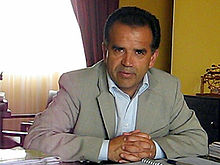 Roberto Córdova, current mayor of Pichilemu, on November 19, 2010.
Roberto Córdova, current mayor of Pichilemu, on November 19, 2010.
Pichilemu, along with the communes of Placilla, Nancagua, Chépica, Santa Cruz, Pumanque, Palmilla, Peralillo, Navidad, Lolol, Litueche, La Estrella, Marchihue, and Paredones, is part of Electoral District No. 35 and belongs to the 9th Senatorial Constituency (O'Higgins) of the electoral divisions of Chile.[50]
Pichilemu is governed by the mayor (alcalde), who manages the executive function. The City Council (concejo municipal) manages the legislative function. The mayors and the councilors are elected popularly every four years, with possibility of re-election.[51] The last elected mayor was Marcelo Cabrera; he was elected in 2008 with 42.08 percent of the vote.[52] He served from May[53] to August 2009, when he was permanently banned from holding public office after being convicted for adulterating tickets.[54] The municipal council elected Roberto Córdova as new mayor on September 9, 2009.[55] Between 2007 and 2009, Pichilemu had seven mayors,[56][57] after Jorge Vargas González was removed from the office for committing the crime of bribery;[57][58] he was mayor for over 10 years, from 1996[59][60][61] to 2007.[57] Vargas was succeeded by Victor Rojas, who was later accused of the same crime and eventually removed from the office too.[62] The current councillors of Pichilemu are Aldo Polanco Contreras, Andrea Aranda Escudero, Viviana Parraguez Ulloa, Patricio Morales Acevedo, Juan Cornejo Vargas, and Marta Urzúa Púa.[55] Their term began in December 2008 (Morales Acevedo's began on September 1, 2009), and will last until 2012.[55]
The Pichilemu Police, known in Spanish as Carabineros de Pichilemu, and officially Tercera Comisaría de Carabineros de Pichilemu, is the police force of Pichilemu. It is commanded by Tomás Molina Meza.[63] The police station is located in front of the former Pichilemu post office building, in Daniel Ortúzar avenue.[63]
Culture and economy
Tourism is the main industry of Pichilemu, especially in the urban center and some rural areas such as Cáhuil and Ciruelos. Forestry, mainly pine and eucalyptus, is another major industry. The area is also known for handicrafts.[11] Although fishing is not very important to O'Higgins Region, due to unsuitable coastlines, it is common in Pichilemu, Bucalemu, and Navidad.[9]
Pichilemu has a clay deposit in the Pañul area.[9] According to archaeological investigations, pottery was first manufactured in the area around 300 BCE. It is still a stalwart today — Ciruelos and El Copao are well-known for the pottery created there.[64]
National monuments
Pichilemu was declared a Typical Zone by the National Monuments Council of Chile, by decree No. 1097 on December 22, 2004.[23]
The city is home to five other National Monuments: Ross Park, Ross Casino, Pichilemu railway station, and Caballo de Agua.[65]
Ross Casino
Main article: Agustín Ross Cultural CentreThe old Ross Casino, currently the Cultural Centre, is located on Agustín Ross Avenue in front of Ross Park (34°23′11.71″S 72°00′34.14″W / 34.3865861°S 72.0094833°W). The three-floor casino was constructed with imported materials in early 1900s by Agustín Ross. It originally housed the first mail and telegraph service and a large store. The first casino in Chile was opened in this building on January 20, 1906.[25][66][67] It operated until 1932, when the Viña del Mar Casino was opened.[68]
The building was renovated and reopened in 2009 as a cultural arts center. It currently houses several gallery spaces and the public library. During its restoration, workers found many historical artifacts, including a copy of Las Últimas Noticias from February 1941 when Ross Casino served as a hotel; an American telephone battery dating from the period of 1909 to 1915; and a tile from the casino's ceiling signed by workers during the building's construction in 1914.[69]
Ross Park and Hotel
Main article: Agustín Ross Park, and Agustín Ross HotelRoss Park was created by Agustín Ross in 1885, and remodeled in December 1987.
“ When he came here, there was nothing. Just a pair of houses, or less. He gave a form to the town, he gave it European looks. Look these balustrades which decorate the slope or the ones which border the park, are the same which Mr. Agustin saw on Biarritz. ” — Jaime Parra, current administrator of Agustín Ross Hotel.[45]The park is located on Agustín Ross Avenue, in front of Ross Casino (34°23′11.41″S 72°00′37.35″W / 34.3865028°S 72.010375°W). The hotel was originally named Gran Hotel Pichilemu (Great Hotel Pichilemu).[45] The once grand Ross Hotel was constructed at the same time, and is one of the oldest hotels in Chile. Although it is still partially open to guests, it is in a state of disrepair.[23]
The park boasts 100-year-old native Chilean palms (Phoenix canariensis) and many green spaces. It was recently restored, and is now a popular walking destination.[70][71]
Both the park and the former casino were named National Monuments on February 25, 1988.[70][72]
Railway station
Main article: Pichilemu railway stationEx Estación de Ferrocarriles, the old railway station, is a wooden building constructed around 1925.[66] It is in front of Petrel Lagoon, near Daniel Ortúzar Avenue (34°23′08.42″S 72°00′09.30″W / 34.3856722°S 72.002583°W). It remained in operation until the 1990s, and became a National Monument on September 16, 1994.[72] It has since become an arts and culture center and tourism information office.[70] It exhibits decorative and practical objects from the 1920s, and features many old clothes.[70]
Railroad history
In the O'Higgins Region, 357 kilometres (222 mi) of railway lines were constructed, but only 161 kilometres (100 mi) still exist.[73] The 119 kilometres (74 mi) San Fernando–Pichilemu section was constructed between 1869 and 1926.[66] Passenger services operated on the line until 1986 and freight services were operational until 1995.[73] In 2006, the Peralillo–Pichilemu section was removed completely.[73][74]
Important places
Pichilemu has many places of interest to tourists. The Bosque Municipal (Municipal Forest) was donated by the Ross family in 1935. The main access to the forest is in front of Ross Casino, near Paseo el Sol; or by a road near the Colegio Preciosa Sangre. The forest has a footpath surrounded by palms, pines, and many other varieties of trees.[75]
Conchal Indígena (Indigenous Midden) is an archaeological site of pre-Hispanic times. It is located on the site of an ancient fishing village 1 kilometre (0.62 mi) from Punta de Lobos and 0.3 kilometres (0.19 mi) south of Los Curas Lagoon.[70][76] Laguna Los Curas (Los Curas Lagoon) is a natural area used for eco-tourist activities such as fishing located 7 kilometres (4.3 mi) south of Pichilemu. Another lagoon, the Laguna del Perro (The Dog's Lagoon) is located 8.5 kilometres (5.3 mi) south of Pichilemu. It is used for recreational activities.[70][76]
Los Navegantes is a neighborhood in Pichilemu, approximately 1.5 kilometres (0.93 mi) in size, which was founded in 1997. After five years of construction, around 30 houses were built. It has a small sports court where residents can play football, basketball, and tennis.
Laguna El Alto (El Alto Lagoon) is a small, rain-fed lagoon located at Chorrillos Beach that is often used for camping and picnics. The lagoon is an hour and a half drive from Pichilemu, traveling to the north by Chorrillos beach.[70] Poza del Encanto is a lagoon located 30 kilometres (19 mi) from Pichilemu. It is home to a large variety of native fauna.[77] The Estero Nilahue (Nilahue Lagoon) is located 15 kilometres (9.3 mi) from Pichilemu. It has several beaches, including El Bronce, El Maquí, and Laguna El Vado.[78]
St. Andrew Church is located in Ciruelos, 13 kilometres (8.1 mi) from Pichilemu. It was constructed in 1779, and its altar was built in the 1940s. It has a harmonium, confessional boxes, and ancient images of saints. Its original image of St. Andrew was made of papier mache. The old parish was created by Archbishop Rafael Valentín Valdivieso in 1864. Cardinal José María Caro was baptized there. The feast day of St. Andrew is celebrated every November 30 at the church.[70][76]
The Museo del Niño Rural (the Rural Kid Museum) was created as an initiative of teacher Carlos Leyton and his students. It is a modern building that utilises traditional architecture. Three rooms contain a collection of stone tools, arrowheads, and clay tools made by the indigenous people of the region. Also on display are domestic tools from early colonists.[79]
El Copao is a hamlet located 14 kilometres (8.7 mi) east of Pichilemu. Its main industry is domestic pottery production, using clay as a raw material.[70] Pañul is a settlement located 17 kilometres (11 mi) from Pichilemu. Its name in Mapudungun means "medicinal herb." Pañul produces pottery made with locally obtained clay.[80] Cáhuil is a small settlement located 13 kilometres (8.1 mi)[70] south of Pichilemu. Its name in Mapudungun means "parrot place". Cahuil lagoon is used for fishing, swimming, and kayaking; kiteboarding lessons are offered on the lagoon. The Cáhuil Bridge is open to motor traffic, and has a view of the Cahuil zone. The bridge provides access to Curicó, Lolol, Bucalemu, and other nearby places.[77]
Beaches
Pichilemu has many expansive dark sand beaches.[81] The water is cool year-round, and many tourists choose to swim at the shore break during the summer months.[81] Common activities include bodyboarding, surfing, windsurfing, and kitesurfing.[82][83]
The northernmost of the beaches is Playa Las Terrazas or Playa Principal (The Terraces Beach or Main Beach), which is in front of Ross Park. It is popular for surfing. Near the beach and at Ross Park, there are balustrades and long stairs dating from the early 1900s. There is a balcony over the rocks at the southern end of the beach.[70] It is the busiest during the summer months. Several surf schools, such as La Ola Perfecta, and Lobos del Pacífico, are located nearby, as is the fish market at Fishermen Creek.[48]
Located south of the town and around the other side of the Puntilla, Playa Infiernillo (Little Hell Beach) is rocky and has tide-pools.[84] This area is used for fishing.[48] South of Infiernillo is Playa Hermosa (Beautiful Beach), which is popular for walking and fishing.[70]
Further south, 6 kilometres (3.7 mi) from Pichilemu, Punta de Lobos features a beach sheltered from the southern winds. It is an increasingly popular destination for tourists and surfers.[83] Several surf contests are held there, including an international big-wave contest during the Chilean fall. The size of waves varies throughout the year. Large swells in fall and winter can reach heights of up to 15 metres (49 ft). It is widely considered one of the best beaches for surfing worldwide.[81]
Surfing
Surfing is a tourist attraction, particularly at Punta de Lobos.[85] According to Fodor's travel guide,[86][87]
[Pichilemu] is Chile's prime surf spot, and people come from around the world to test their skills. ... [Punta de Lobos] is widely considered the best surfing in South America year-round.—Fodor's Chile: Including Argentine PatagoniaEvery October and December, an International Championship of Surf is held at La Puntilla Beach.[88] Punta de Lobos hosts the Campeonato Nacional de Surf (National Surfing Championship) every summer.[24][89][90]
Media
The local newspaper, called El Expreso de la Costa,[91] has a circulation area that covers most of Cardenal Caro Province. It is directed by Félix Calderón.[91] There is an online newspaper in Spanish called Pichilemu News.[92] It is edited by Washington Saldías, former councillor of the city.[92] The magazine Hola Vecino circulated between 2007 and 2008 in most of O'Higgins Region and was directed by Francisco Espejo.[91]
Radio services come from Radio Entre Olas,[91] Radio Atardecer,[91] Radio Somos Pichilemu (directed by former Mayor Jorge Vargas González and his wife and current Councillor Andrea Aranda), Radio Isla,[91] and Radio Corporación.[93] A television channel, Canal 3 Pichilemu, also broadcasts in the area.[94]
Education
Pichilemu has no higher education establishments, although it has many primary and secondary schools, including: Charly's School, a primary and secondary school in El Llano;[95] Escuela Digna Camilo Aguilar (Digna Camilo Aguilar School), a primary school near Charly's School;[96] Colegio Libertadores (Liberators School), a primary school in Infiernillo; Colegio Preciosa Sangre (Precious Blood School), a primary and secondary school near El Llano; Colegio Divino Maestro (Divine Master School), a primary school near Pueblo de Viudas; and Escuela Pueblo de Viudas (Pueblo de Viudas School), a primary school in Pueblo de Viudas.[97]
Other schools include the Liceo Agustín Ross Edwards (Agustín Ross Edwards High School), a secondary school in El Llano, near Escuela Digna Camilo Aguilar and Charly's School, and Jardín Amanecer (Dawn Garden), a kindergarten school in El Llano.[97]
Important dates
Date[98] Festivity[98] Place[98] December 31 – January 1 Año Nuevo Junto al Mar (New Year with the Sea) Agustín Ross Park, in front of the Agustín Ross Cultural Centre February 6 – February 19 Semana Pichilemina (Pichileminian Week) Pichilemu February 16 – February 21 Fiesta Costumbrista Folclore Junto al Mar (Folklore and Local Customs Festival with the Sea) Arturo Prat Square, Pichilemu February 25 – February 26 Trilla a Yegua Suelta (Threshing with Horses) La Puntilla, Pichilemu Between March and April (date varies) Semana Santa en Pichilemu (Passion Week in Pichilemu) Inmaculada Concepción Parish, Pichilemu April 9 Muestra Nacional de Cueca (National Cueca Demonstration) Municipal Gymnasium of Pichilemu September 17 – September 19 Fiestas Patrias ("Independence Day of Chile" or "National Holiday") Pichilemu September 18 – September 21 Campeonato Estudiantil de Surf (Student Surf Championship) La Puntilla Beach and Punta de Lobos November 30 Feast day of Saint Andrew Ciruelos December 8 Fiesta de la Purísima (Inmaculate Conception Festival) Inmaculada Concepción Parish, Pichilemu See also
- Outline of Chile
- List of cities in Chile
- People from Pichilemu
References
- ^ a b c Medina, José Toribio (1908) (in Spanish). Los restos indígenas de Pichilemu [The indigenous remains of Pichilemu]. Imprenta Cervantes. http://www.archive.org/details/losrestosindgen00medigoog. Retrieved July 20, 2010.
- ^ Saldías, Washington (September 1, 2009). "Alcalde titular "Habemus" en Pichilemu: Roberto Córdova elegido trans resolución del Tricel ["Habemus" Acting Mayor in Pichilemu: Roberto Córdova is elected after Tricel resolution]" (in Spanish). Pichilemu News. http://pichilemunews.blogcindario.com/2009/09/03107-alcalde-titular-habemus-en-pichilemu-roberto-cordova-carreno-elegido-tras-resolucion-del-tricel.html. Retrieved December 4, 2009.
- ^ "Chile Time". World-Time-Zones.org. http://www.world-time-zones.org/zones/chile-time.htm. Retrieved May 5, 2007.
- ^ "Chile Summer Time". World-Time-Zones.org. http://www.world-time-zones.org/zones/chile-summer-time.htm. Retrieved May 5, 2007.
- ^ Pichilemo (Puerto de) entry at Diccionario Geográfico de la República de Chile (1899) at Wikisource, by Francisco Astaburuaga Cienfuegos. (Spanish)
- ^ a b Carmen del Río Pereira – Blanca Tagle Arduengo. "Historia regional desde la llegada del español hasta el siglo XIX : Los pueblos precolombinos [Regional history since the Spaniards arrival until the XIX century : The Pre-Columbian peoples]" (in Spanish). Pro-O'Higgins. http://www.pro-ohiggins.cl/libro/cuerpo/2_2_1.html. Retrieved August 19, 2010.
- ^ Sarmiento, Domingo Faustino (1915) (in Spanish). Conflicto y armonías de las razas en América [Conflict and harmony of the races in America]. Buenos Aires : "La Cultura Argentina". http://www.archive.org/details/conflictoyarmo00sarm. Retrieved September 11, 2010.
- ^ Oyarzún, Aureliano (1957) (in Spanish). Crónicas de Pichilemu–Cahuil [Chronicles of Pichilemu–Cáhuil]. Imprenta Universitaria, Publicaciones del Museo de Etnología y Antropología de Chile, Nº 4 and 5, Year I.
- ^ a b c d e Carmen del Río Pereira Blanca Tagle Arduengo (2009) (in Spanish). Región de O'Higgins: Breve relación del patrimonio natural y cultural [O'Higgins Region: Brief relationship of the natural and cultural heritage]. Pro-O'Higgins.
- ^ a b Carmen del Río Pereira Blanca Tagle Arduengo (2009) (in Spanish). "Historia regional desde la llegada del español hasta el siglo XIX: Actividades económicas" (in Spanish). Pro-O'Higgins. http://www.pro-ohiggins.cl/libro/cuerpo/2_2_3.html. Retrieved 21 August 2010.
- ^ a b c d e f g Carla Ramírez Lechuga (2007). "Edificio Consistorial I. Municipalidad de Pichilemu [Town Hall Illustrious Municipality of Pichilemu]" (in Spanish). University of Chile. http://www.cybertesis.cl/tesis/uchile/2004/ramirez_c2/sources/ramirez_c2.pdf. Retrieved April 14, 2010. (thesis)
- ^ a b León Vargas, Victor (1996) (in Spanish). En Nuestra Tierra Huasa de Colchagua. Energía y Motores. [In Our Huasa Land of Colchagua: Energy and Motors.]. Santiago de Chile: Ed. Museo de Colchagua – Impresos Universitaria, S.A..
- ^ a b c Saldías, Washington (November 16, 2006). "Puerto en Pichilemu: Histórica Bitácora del Engaño [Port in Pichilemu: Historical Log of the Deception]" (in Spanish). Pichilemu News. http://pichilemunews.blogcindario.com/2006/11/01068-puerto-en-pichilemu-historica-bitacora-del-engano.html. Retrieved January 6, 2010.
- ^ a b "Reseña Histórica de Pichilemu [Historical overview of Pichilemu]" (in Spanish). DePichilemu. http://www.depichilemu.cl/historia.htm. Retrieved December 5, 2009.
- ^ a b c Marisol D. Muñoz Hernandez. "AO501-1 Taller de Diseño Arquitectonico 1 2010, Semestre Otoño [AO501-1 Architectural Design Workshop 1 2010, Autumn Semester]" (in Spanish). Universidad de Chile. https://www.u-cursos.cl/fau/2010/1/AO501/1/material_alumnos/objeto/10442. Retrieved August 19, 2010.
- ^ "Diccionario Mapuche [Mapuche Dictionary]" (in Spanish). Escolares.net. http://www.escolares.net/descripcion.php?ide=563. Retrieved August 15, 2010.
- ^ Jorge Núñez P. (May 2003) (in Spanish). 1891, crónica de la guerra civil [1891, chronicle of the civil war]. ISBN 956-282-527-2. http://books.google.com/?id=n71SIc6IZE8C&pg=PA38&lpg=PA38&dq=pichilemu+guerra+civil+1891&q=Pichilemu. Retrieved December 16, 2009.
- ^ a b c d "Pichilemu y su historia" (in Spanish). Pichilemu. Archived from the original on 25 June 2008. http://web.archive.org/web/20080625070813/http://www.pichilemu.cl/turismo/historia/index.htm. Retrieved 21 August 2010. (Internet Archive)
- ^ a b c Saldías, Washington (August 2, 2007). "Alcaldes, regidores y concejales de la comuna de Pichilemu [Mayors, aldermen and councillors of the commune of Pichilemu]" (in Spanish). Pichilemu News. http://pichilemunews.blogcindario.com/2007/08/01679-alcaldes-regidores-y-concejales-de-la-comuna-de-pichilemu.html. Retrieved August 15, 2010.
- ^ Millas, Hernán (2005) (in Spanish). La Sagrada Familia [The Sacred Family]. Editorial Planeta. ISBN 956-247-381-3.
- ^ Saldías, Washington (February 5, 2010). "Don Agustín Ross Edwards: A 166 años del natalicio del impulsor del balneario de Pichilemu [Sir Agustín Ross Edwards: 166 years from the birth of the promoter of the Pichilemu resort]" (in Spanish). Pichilemu News. http://pichilemunews.blogcindario.com/2010/02/03270-don-agustin-ross-edwards-a-166-anos-del-natalicio-del-impulsor-del-balneario-de-pichilemu.html. Retrieved August 15, 2010.
- ^ "Agustín Ross Edwards – Senador [Agustín Ross Edwards - Senator]" (in Spanish). Biblioteca Nacional de Chile. http://biografias.bcn.cl/pags/biografias/detalle_par.php?id=712. Retrieved August 15, 2010.
- ^ a b c d e f Chrisitian Matzner (December 22, 2004). "Sector de Pichilemu [Pichilemu area]". National Monuments Council. http://www.monumentos.cl/OpenSupport_Monumento/asp/PopUpFicha/ficha_publica.asp?monumento=595. Retrieved December 5, 2009.
- ^ a b Charlotte Beech, Jolyon Attwooll, Thomas Kohnstamm, and Andrew Dean Nystrom (May 1, 2006). Chile and Easter Island. Footscray, Victoria, Australia: Lonely Planet. ISBN 9781740599979. http://books.google.com/?id=mw0KeQWVtsEC&pg=PT138#v=onepage&q=.
- ^ a b "Casino (antiguo) de Pichilemu y los Jardínes del Parque Agustin Ross [(Old) Casino of Pichilemu and the Gardens of the Agustín Ross Park]" (in Spanish). National Monuments Council. http://www.monumentos.cl/OpenSupport_Monumento/asp/PopUpFicha/ficha_publica.asp?monumento=1173. Retrieved December 6, 2009.
- ^ Saldías, Washington (October 3, 2005). "Provincia Cardenal Caro de cumpleaños" (in Spanish). Pichilemu, Chile: Pichilemu News. http://pichilemunews.blogcindario.com/2005/10/00370-provincia-cardenal-caro-de-cumpleanos.html. Retrieved November 9, 2010.
- ^ "Chile". Library of Congress. http://lcweb2.loc.gov/frd/cs/chile/cl_appen.html. Retrieved September 12, 2010.
- ^ "Cardenal Caro" (in Spanish). VI.cl. http://www.vi.cl/secciones/turismo/cardenal_caro.html. Retrieved December 4, 2009.
- ^ "Pichilemu queda devastado tras el tsunami que afectó a la zona costera [Pichilemu devastated after tsunami that affected coastal area]" (in Spanish). Radio Bío Bío. March 2, 2010. http://www.radiobiobio.cl/2010/03/02/pichilemu-queda-devastado-tras-el-tsunami-que-afecto-a-la-zona-costera/. Retrieved August 1, 2010.
- ^ "Informe de Sismo. [Earthquake Report.]" (in Spanish). University of Chile. March 11, 2010. http://sismologia.cl/events/sensibles/2010/03/20100311143929.html. Retrieved August 17, 2010.
- ^ "Magnitude 6.9 – LIBERTADOR O'HIGGINS, CHILE". USGS. March 11, 2010. http://earthquake.usgs.gov/earthquakes/recenteqsww/Quakes/us2010tsa6.php. Retrieved August 17, 2010.
- ^ "Hombre fallece en Talca de un paro cardíaco en medio de fuertes réplicas [Man dies in Talca of a heart attack amidst strong aftershocks]" (in Spanish). La Tercera. March 11, 2010. http://www.latercera.com/contenido/680_233172_9.shtml. Retrieved August 1, 2010.
- ^ "Pichilemu". Encyclopaedia Britannica. 2008. http://www.britannica.com/EBchecked/topic/459359/Pichilemu.
- ^ "Pichilemu to San Fernando". Google Maps Chile. http://maps.google.cl/maps?f=d&source=s_d&hl=es&geocode=&saddr=pichilemu&daddr=san+fernando&sll=-34.584006,-70.987426&sspn=0.065435,0.154324&g=san+fernando&ie=UTF8&z=10. Retrieved December 16, 2009.
- ^ "Relieve Región Libertador B. O'Higgins [Relief [of Libertador B. O'Higgins Region]"]. Biblioteca del Congreso Nacional de Chile. http://siit2.bcn.cl/nuestropais/region6/relieve.htm. Retrieved August 8, 2010.
- ^ Pichilemu.cl. "Pichilemu antes [Pichilemu before]" (in Spanish). Archived from the original on 2006-08-08. http://web.archive.org/web/20060808223302/http://pichilemu.cl/turismo/historia/animacion/Pichilemu%20antes.exe. Retrieved March 18, 2010.
- ^ a b c National Statistics Institute of Chile. "O'Higgins Region Statistics 2002 census" (in Spanish). http://alerce.ine.cl/canales/chile_estadistico/censos_poblacion_vivienda/censo2002/mapa_interactivo/sexta.swf. Retrieved December 5, 2009.
- ^ Fernández, O. (May 22, 2010). "Pichilemu tiene falla geológica que genera oleada de réplicas en esa zona [Pichilemu has geological fault that generates wave of aftershocks in that area]" (in Spanish). Santiago, Chile: La Tercera. http://latercera.com/contenido/680_261687_9.shtml. Retrieved October 30, 2010.
- ^ Correa, Paula. "Sismólogos advierten sobre la activación de fallas después del terremoto [Seismologists warn about activation of faults after the earthquake]" (in Spanish). Radio Universidad de Chile (Santiago, Chile: Universidad de Chile). http://radio.uchile.cl/noticias/72407/. Retrieved October 30, 2010.
- ^ Petrel entry at Diccionario Geográfico de la República de Chile (1899) at Wikisource, by Francisco Astaburuaga Cienfuegos. (Spanish)
- ^ San Miguel de la Palma entry at Diccionario Geográfico de la República de Chile (1899) at Wikisource, by Francisco Astaburuaga Cienfuegos. (Spanish)
- ^ Garzas (Las) entry at Diccionario Geográfico de la República de Chile (1899) at Wikisource, by Francisco Astaburuaga Cienfuegos. (Spanish)
- ^ Alto Colorado entry at Diccionario Geográfico de la República de Chile (1899) at Wikisource, by Francisco Astaburuaga Cienfuegos. (Spanish)
- ^ "Clima de Chile Región Libertador Gral. Bernardo O'Higgins [Weather of Chile: Libertador Gral. Bernardo O'Higgins Region]" (in Spanish). Castor y Polux Ltda.. http://www.mapasdechile.com/clima_region06/index.htm. Retrieved December 6, 2009.
- ^ a b c Revista Sábado, El Mercurio. "Balnearios con Historia (III) [Beach resorts with history (III)]" (in Spanish). http://melisa-recorridoporlasextaregion.blogspot.com/2008/01/el-que-fuera-el-ms-glamoroso-de-los.html. Retrieved December 5, 2009.
- ^ a b c d Carmen del Río Pereira and Blanca Tagle Arduengo (in Spanish). Región de O'Higgins: Breve Relación del Patrimonio Natural y Cultural [O'Higgins Region: Brief Relationship of the Natural and Cultural Heritage]. http://www.pro-ohiggins.cl/libro/cuerpo/3_1_4.html. Retrieved December 5, 2009.
- ^ a b c Saldías, Washington (November 11, 2009). "Censo de 1787: La Superintendencia y el Diputado de Cáhuil, José González [1787 Census: The Superintendence and the Deputy of Cáhuil, José González]" (in Spanish). PichilemuNews. http://pichilemunews.blogcindario.com/2009/11/03185-censo-de-1787-la-superintendencia-y-el-diputado-de-cahuil-jose-gonzalez.html. Retrieved December 5, 2009.
- ^ a b c "PICHILEMU: Historia, estadísticas, mapas [Pichilemu: History, statistics, maps]" (in Spanish). Mi Balcón. http://mibalcon.cl/vi-reg/hist156.htm. Retrieved December 5, 2009.
- ^ "Ficha Comunal Pichilemu" (in Spanish). National Municipal Information Service (Servicio Nacional de Información Municipal). 2010. http://www.sinim.gov.cl/ficha_comunal/fcomunal.php?id_muni=06201&ano=2009&periodo=A. Retrieved 15 August 2011.
- ^ Chile Government. "Sistema de Despliegue de Cómputos — Ministerio del Interior" (in Spanish). Ministerio del Interior. http://www.elecciones.gov.cl/Sitio2009/p-cs9.htm. Retrieved January 12, 2010.
- ^ "Chile: Political Organization / Organización Política" (in Spanish). Political Database of the Americas. University of Georgetown. February 17, 2005. http://pdba.georgetown.edu/Decen/Chile/chile.html. Retrieved February 2, 2011.
- ^ "Votación Candidatos por Comuna Pichilemu Alcaldes 2008 [Voting for Candidates of the Pichilemu commune - Mayors Election 2008]" (in Spanish). Ministerio del Interior. http://elecciones.gob.cl/SitioHistorico/paginas/2008/alcaldes/comunas/candidatos/total/4801.htm. Retrieved December 15, 2009.
- ^ El Rancahuaso Correspondents (May 19, 2009). "Marcelo Cabrera asumió como alcalde de Pichilemu [Marcelo Cabrera assumed as mayor of Pichilemu]" (in Spanish). El Rancahuaso. http://www.elrancahuaso.cl/admin/render/noticia/19000. Retrieved December 4, 2009.
- ^ El Rancahuaso Correspondents (August 19, 2008). "¡Increíble!, Pichilemu otra vez se quedó sin alcalde [Incredible! Pichilemu has no mayor again]" (in Spanish). El Rancahuaso. http://www.elrancahuaso.cl/admin/render/noticia/20179. Retrieved December 15, 2009.
- ^ a b c "Autoridades [Authorities]" (in Spanish). Pichilemu. http://pichilemu.cl/mun.php. Retrieved August 11, 2010.
- ^ El Rancahuaso Team (February 2, 2009). "Hasta 3 años de Cárcel arriesga el Alcalde de Pichilemu [Up to three years in prison risks Mayor of Pichilemu]" (in Spanish). El Rancahuaso. http://www.elrancahuaso.cl/admin/render/noticia/17884. Retrieved December 4, 2009.
- ^ a b c Saldías, Washington (June 7, 2007). "Alcalde de Pichilemu, Jorge Vargas, definitivamente culpable del delito de cohecho [Mayor of Pichilemu, Jorge Vargas, definitely guilty for the crime of bribery]". Pichilemu News. http://pichilemunews.blogcindario.com/2007/06/01582-alcalde-de-pichilemu-jorge-vargas-definitivamente-culpable-del-delito-de-cohecho.html. Retrieved December 15, 2009.
- ^ "Pichilemu: Querella por mal uso de fondos municipales [Pichilemu: Complaint for misuse of municipal funds]" (in Spanish). El Mercurio. May 3, 2003. http://diario.elmercurio.cl/detalle/index.asp?id={aa0b838a-92e3-40b6-bb6e-1448c391fbf7}. Retrieved January 5, 2010.
- ^ "Votación Candidatos por Comuna Pichilemu Municipales 1996 [Voting for Candidates of the Pichilemu commune - Municipal Election 1996]" (in Spanish). Ministerio del Interior. http://elecciones.gob.cl/SitioHistorico/paginas/1996/municipales/comunas/candidatos/total/4801.htm. Retrieved December 15, 2009.
- ^ "Votación Candidatos por Comuna Pichilemu Municipales 2000 [Voting for Candidates of the Pichilemu commune - Municipal Election 2000]" (in Spanish). Ministerio del Interior. http://elecciones.gob.cl/SitioHistorico/paginas/2000/municipales/comunas/candidatos/total/4801.htm. Retrieved December 15, 2009.
- ^ "Votación Candidatos por Comuna Pichilemu Alcaldes 2004 [Voting for Candidates of the Pichilemu commune - Mayors Election 2004]" (in Spanish). Ministerio del Interior. http://elecciones.gob.cl/SitioHistorico/paginas/2004/alcaldes/comunas/candidatos/total/4801.htm. Retrieved December 15, 2009.
- ^ Cynthia Rey (September 13, 2007). "Alcalde y ex edil de Pichilemu quedan en prisión preventiva [Mayor and former aedile of Pichilemu remains in custody]" (in Spanish). El Rancahuaso. http://www.elrancahuaso.cl/admin/render/noticia/11056. Retrieved September 11, 2010.
- ^ a b "Carabineros - 3ª Comisaria Pichilemu - Pichilemu, VI, - (72) 972-394" (in Spanish). Amarillas. 2010. http://geo.amarillas.com/page/es/16-300094278.html. Retrieved 11 September 2010.
- ^ Carmen del Río and M. Blanca Tagle (1998) (in Spanish). Una aproximación a nuestras raíces indígenas [An approximation to our indigenous roots]. Santiago de Chile: Editorial Platero.
- ^ Saldías, Washington (May 22, 2008). "Cinco Monumentos Nacionales, Una Zona Típica en Pichilemu y el Día del Patrimonio Nacional [Five National Monuments, a Traditional Area in Pichilemu and the Day of the National Heritage]" (in Spanish). Pichilemu News. http://pichilemunews.blogcindario.com/2008/05/02263-cinco-monumentos-nacionales-una-zona-tipica-en-pichilemu-y-el-dia-del-patrimonio-nacional.html. Retrieved December 5, 2009.
- ^ a b c Antonio Saldías González (1990) (in Spanish). Pichilemu: Mis fuentes de información [Pichilemu: My information sources]. El Promoucae. http://www.google.com/books?id=KfwbAAAAIAAJ. Retrieved January 12, 2010.
- ^ Chile.com. "Pichilemu" (in Spanish). Chile.com. http://www.chile.com/tpl/articulo/detalle/ver.tpl?cod_articulo=97835. Retrieved December 7, 2009.
- ^ Saldías, Washington (January 14, 2007). "Identidad local y Casino Ross de Pichilemu [Local identity and Ross Casino of Pichilemu]" (in Spanish). Pichilemu News. http://pichilemunews.blogcindario.com/2007/01/01231-identidad-local-y-casino-ross-de-pichilemu.html. Retrieved July 5, 2010.
- ^ Beatriz Valenzuela (October 29, 2007). "Hallazgos históricos en la obra de restauración del ex casino Ross de Pichilemu [Historical findings in the work of restoration of the former Ross Casino of Pichilemu]" (in Spanish). El Rancahuaso. http://www.elrancahuaso.cl/admin/render/noticia/11636. Retrieved December 5, 2009.
- ^ a b c d e f g h i j k l María José Muñoz (February 24, 2007). "Atractivos de nuestra región. Hoy: Pichilemu [Attractions of our region. Today: Pichilemu]" (in Spanish). El Rancahuaso. http://www.elrancahuaso.cl/admin/render/noticia/7987. Retrieved December 5, 2009.
- ^ "VI Región Playas [VI Region: Beaches]" (in Spanish). Chile.com. http://www.chile.com/tpl/articulo/detalle/ver.tpl?cod_articulo=1146. Retrieved December 5, 2009.
- ^ a b "Monumentos Nacionales de la VI Región [National Monuments of the VI Region]" (in Spanish). VI.cl. http://www.vi.cl/secciones/turismo/monumentos.html. Retrieved December 5, 2009.
- ^ a b c Benedicto González (December 2, 2007). "Historia del ferrocarril San Fernando a Pichilemu [History of the San Fernando to Pichilemu railway]" (in Spanish). Pichilemu News. http://pichilemunews.blogcindario.com/2007/12/01907-historia-del-ferrocarril-san-fernando-a-pichilemu.html. Retrieved December 5, 2009.
- ^ "Historia del Ferrocarril San Fernando a Pichilemu [History of the San Fernando to Pichilemu railway]" (in Spanish). De Colchagua. http://www.decolchagua.cl/modules.php?name=News&file=article&sid=4349. Retrieved December 5, 2009.
- ^ "Atractivos Turísticos Cardenal Caro [Touristic Attractions of Cardenal Caro]". De Colchagua. http://www.decolchagua.cl/secciones/turismo/cardenal_caro.html. Retrieved August 17, 2010.
- ^ a b c "Cardenal Caro" (in Spanish). VI.cl. http://www.vi.cl/secciones/turismo/cardenal_caro.html. Retrieved December 15, 2009.
- ^ a b "Lugares [Places]" (in Spanish). Pichilemu.net. http://www.pichilemu.net/Link/lugar.htm. Retrieved December 16, 2009.
- ^ El Rancahuaso Staff (April 2009). "Los Imperdibles de Pichilemu [The Unforgettables of Pichilemu]". El Rancahuaso. http://www.elrancahuaso.cl/admin/render/noticia/17439&print=true. Retrieved August 8, 2010.
- ^ "Museo "Del niño rural" [Museum "of the Rural Kid"]" (in Spanish). VI.cl. http://www.vi.cl/museosycasaspatronales/museociruelos. Retrieved December 16, 2009.
- ^ "Pañul" (in Spanish). DePichilemu. http://www.depichilemu.cl/panul.htm. Retrieved December 16, 2009.
- ^ a b c "Pichilemu" (in Spanish). Educasitios–educ.ar. http://educasitios.educ.ar/grupo1176/?q=node/52. Retrieved December 5, 2009.
- ^ "Al Compás de las Olas [To the rhythm of the waves]" (in Spanish). Chile.com. http://www.chile.com/secciones/ver_seccion.php?id=25596. Retrieved August 11, 2010.
- ^ a b "Surfin' in Pichilemu" (in Spanish). Pichilemu. Archived from the original on July 25, 2008. http://web.archive.org/web/20080725095602/http://www.pichilemu.cl/turismo/surf/Ingles/. Retrieved December 5, 2009.
- ^ "Sailing Directions (Enroute) – West Coast of South America". National Geospatial-Intelligence Agency. 2010. http://msi.nga.mil/MSISiteContent/StaticFiles/NAV_PUBS/SD/Pub125/Pub125bk.pdf. Retrieved September 12, 2010.
- ^ Saldías, Washington (August 31, 2009). "Tercer Campeonato Estudiantil de Surf 2009: todo un éxito [Third Student Surf Championship 2009: a success]" (in Spanish). Pichilemu News. http://pichilemunews.blogcindario.com/2009/08/03105-tercer-campeonato-estudiantil-de-surf-2009-todo-un-exito.html. Retrieved December 5, 2009.
- ^ Fodor's (2008). Taplan, Alan. ed. Fodor's Chile: Including Argentine Patagonia. New York: Random House. p. 218. ISBN 978-1-4000-1967-0. http://books.google.com/?id=x7igKTnjveAC.
- ^ "Surfistas esperan "la gran ola" en Pichilemu [Surfers wait for "the great wave" in Pichilemu]" (in Spanish). Chilevisión. http://www.chilevision.cl/home/index.php?option=com_content&task=view&id=169249&Itemid=81. Retrieved January 6, 2010. (Video)
- ^ "Pichilemu" (in Spanish). VI.cl. http://www.vi.cl/ciudadesyatractivos/pichilemu. Retrieved August 17, 2010.
- ^ Angela Neira (April 2, 2010). "Pichilemu convoca a mejores surfistas del mundo para participar en evento extremo [Pichilemu convokes the best surfers of the world to participate in extreme event]" (in Spanish). La Tercera. http://latercera.com/contenido/680_238850_9.shtml. Retrieved August 15, 2010.
- ^ Carlos Jimeno Ocares (August 1, 2008). "Mundial de Surf en Olas Gigantes entraría al agua la próxima semana [World Surf [Championship in Giant waves to begin next week]"] (in Spanish). El Mercurio. http://www.emol.com/noticias/deportes/detalle/detallenoticias.asp?idnoticia=315673. Retrieved August 15, 2010.
- ^ a b c d e f "prensa regional – Gobierno Regional O'Higgins [Regional Press - Regional Government of O'Higgins]" (in Spanish). O'Higgins Region Government. 2007. http://www.goreohiggins.cl/LISTADOPRENSA2007.xls. Retrieved August 1, 2010.
- ^ a b "Quienes Somos [Who We Are]" (in Spanish). Pichilemu News. http://www.pichilemunews.cl/_sitios/_colaboradores/somos.html. Retrieved August 1, 2010.
- ^ "Radio Corporación de Pichilemu" (in Spanish). Pichilemu, Chile: Radio Corporación de Pichilemu. November 4, 2011. http://corporacionpichilemu.com/. Retrieved November 4, 2011.
- ^ Cornejo, Cristóbal. "Canal 3 de Pichilemu: Televisión comunitaria desde la Sexta Región [Canal 3 of Pichilemu: Communitary television from the sixth region]" (in Spanish). El Ciudadano (Los Ríos Region, Chile: Mentes X Comunicaciones). http://www.elciudadano.cl/2010/05/29/canal-3-de-pichilemu-television-comunitaria-desde-la-sexta-region/. Retrieved December 9, 2010.
- ^ Ministry of Education of Chile (2008). "Ficha Establecimiento (Charly's School)" (in Spanish). SIMCE. http://www.simce.cl/simce/index.php?id=228&iRBD=15522&iVRBD=5&iNivel=0&iAnio=. Retrieved July 11, 2010.
- ^ Ministry of Education of Chile (2008). "Ficha Establecimiento (Digna Camilo Aguilar)" (in Spanish). SIMCE. http://www.simce.cl/simce/index.php?id=228&iRBD=11261&iVRBD=5&iNivel=0&iAnio=. Retrieved July 11, 2010.
- ^ a b "Región del Libertador General Bernardo O'Higgins [Libertador General Bernardo O'Higgins Region]" (in Spanish). Ministry of Education of Chile. http://www.mineduc.cl/index2.php?id_seccion=722&id_portal=7&id_contenido=4326. Retrieved July 5, 2010.
- ^ a b c Pamphlet Pichilemu, Mágico & Natural [Pichilemu, Magic and Natural], published by the Municipality of Pichilemu, in February 2010. Languages English and Spanish.
Further reading
- Arraño Acevedo, José (1999) (in Spanish). Pichilemu y Sus Alrededores Turísticos. Pichilemu, Chile: Editora El Promoucae.
- Arraño Acevedo, José (June 2003) (in Spanish). Hombres y Cosas de Pichilemu. Pichilemu, Chile.
- Boza Díaz, Cristián (1986) (in Spanish). Balnearios tradicionales de Chile: su arquitectura. Santiago, Chile: Editorial Montt Palumbo.
- Del Río Pereira, Carmen and Gutierrez Marín, Fernando (May 2002) (in Spanish). Patrimonio Arquitectónico de la Sexta Región, 4º Parte. Santiago, Chile.
- Donoso Fernández, Mariana (2000) (in Spanish). 10 Concursos Nacionales Iglesis Prat Arquitectos; Editorial FAU U. de Chile. Santiago, Chile.
- Medina, José Toribio (1908) (in Spanish). Los Restos Indígenas de Pichilemu. Santiago, Chile. — Available at Spanish Wikisource
- Mella Polanco, Juan (February 1996) (in Spanish). Historia Urbana de Pichilemu: Origen y crecimiento. Chile: Editorial Bogavantes.
- Saldías González, Antonio (1990) (in Spanish). Pichilemu, mis fuentes de información. Pichilemu, Chile: Editora El Promaucae.
External links
- Official website (Spanish)
- Official Cahuil website (English)
- News site of Pichilemu (Spanish)

Litueche La Estrella 
Pacific Ocean 
Marchihue  Pichilemu
Pichilemu 

Paredones Pumanque / Lolol  Pichilemu
Pichilemu- History
- Coat of arms
- Flag
- Notable people
Government - Town Hall
- Mayor
- (Roberto Córdova)
- City Council
- (Aldo Polanco
- Andrea Aranda
- Viviana Parraguez
- Juan Cornejo
- Marta Urzúa
- Patricio Morales)
- Police
- Public Safety Agency
- Fire
- Library
- Education
Attractions - Agustín Ross Cultural Center
- Agustín Ross Park
- Railway Station
- Túnel El Árbol
- Caballo de Agua
- Agustín Ross Hotel
- Agustín Ross Balcony
- Cáhuil
- La Cruz Hill
- Los Navegantes
- Punta de Lobos
Colleges and Schools - Agustín Ross Edwards High School
- Charly's School
- Digna Camilo Aguilar School
- Preciosa Sangre School
See also - 1985 Pichilemu earthquake
- 2003–2009 Pichilemu political controversies
- 2010 Pichilemu earthquake
- Los Restos Indígenas de Pichilemu
< Communes and municipalities in O'Higgins Region > Cachapoal Province 
Cardenal Caro Province Colchagua Province Chépica · Chimbarongo · Lolol · Nancagua · Palmilla · Peralillo · Placilla · Pumanque · San Fernando · Santa CruzCoordinates: 34°23′31″S 72°00′50″W / 34.39194°S 72.01389°W
Categories:- Pichilemu
- Populated places established in 1544
- Populated places in Cardenal Caro Province
- Capitals of Chilean provinces
- Beaches of Chile
- Communes of Chile
- Monuments and memorials in Chile
- Monuments and memorials in Pichilemu
- Visitor attractions in Chile
- Populated coastal places in Chile
- Surfing locations by country
Wikimedia Foundation. 2010.


